AEG S54800DNW0 Manual
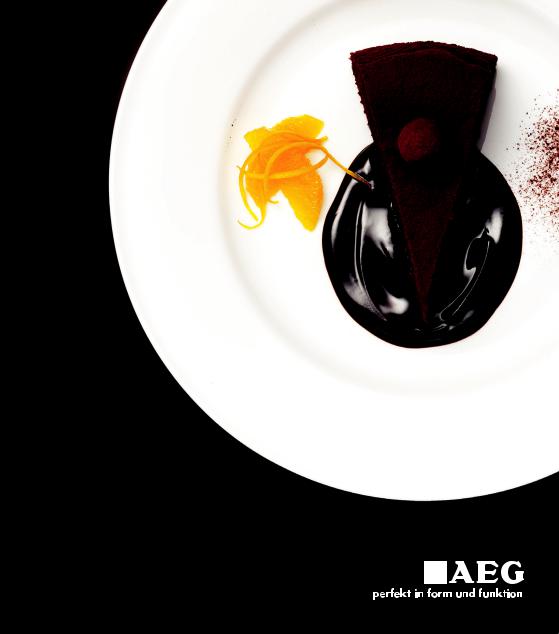
S54800DNW0 |
UK |
NO-FROST Refrigerator |
User manual |
|
FR |
NO-FROST Réfrigérateur |
Guide d’utilisation |
|
EL |
NO-FROST Ψυγείο |
Οδηγίες Χρήσης |
Index |
|
BEFORE USING THEAPPLIANCE ..................................................................... |
2 |
Safety Instructions ........................................................................................................... |
2 |
Recommendations ......................................................................................................... |
3 |
Installation and Switching On The Appliance ............................................................... |
4 |
Before Switching On ........................................................................................................ |
4 |
THE VARIOUS FUNCTION AND POSSIBILITIES ............................................... |
5 |
Thermostat Setting .......................................................................................................... |
5 |
Accessories ..................................................................................................................... |
6 |
Magic Shelf ............................................................................................................................... |
6 |
Making Ice Cubes ..................................................................................................................... |
6 |
Fast Freezing Shelf .................................................................................................................. |
6 |
Chiller Shelves .......................................................................................................................... |
7 |
Crisper and Crisper Shelf ........................................................................................................ |
7 |
REMOVING THECRISPER COVER .......................................................................................... |
8 |
ARRANGING FOOD IN THE APPLIANCE .......................................................... |
9 |
Refrigerator Compartment ............................................................................................. |
9 |
Freezer Compartment ................................................................................................... |
10 |
CLEANING AND MAINTENANCE ...................................................................... |
14 |
Defrosting ...................................................................................................................... |
14 |
Replacing The Refrigerator and Freezer Light Bulb .................................................. |
15 |
TRANSPORTATION AND CHANGING OF INSTALLATION POSITION .............. |
15 |
Changing of Door Opening Direction .......................................................................... |
15 |
BEFORE CALLING YOUR AFTER SALES SERVICE ......................................... |
16 |
THE PARTS OF THE APPLIANCE AND THE COMPARTMENTS ....................... |
18 |
Tips For Saving Energy ................................................................................................. |
19 |
UK - 1 -

PART- 1. BEFORE USING THE APPLIANCE
Safety Instructions
•If the model contains R600a-see name plate under refrigerant (the coolant isobutane), naturals gas that, is very environmentally friendly but also combustible. When transporting and installing the unit care must be taken to ensure that none of the refrigeration circuit components become damaged. In the event of damage avoid naked flames or ignition sources and ventilate the room in which the unit is placed for a few minutes.
Warning: Keep ventilation openings in appliance enclosure or in structure for building in, clear of obstruction.
•Do not use mechanical devices or other artificial means to accelerate the defrosting process.
•Do not use electrical appliances in the refrigerator or freezer compartment of the appliance.
•If this appliance is to replace an old refrigerator with a lock; break or remove the lock as a safety measure before storing it, to protect children while playing might lock themselves inside.
•Old refrigerators and freezers contain insulation gases and refrigerant, which must be disposed of properly. Entrust the disposal of a scrap unit categorically to competence of your local waste disposal service and contact your local authority or your dealer if you have any questions. Please ensure that the pipe of work of your refrigerating unit does not get damaged prior to being picked-up by the relevant waste disposal service.
Important note:
Please read this booklet before installing and switching on this appliance. The manufacturer assumes no responsibility for incorrect installation and usage as described in this booklet.
UK - 2 -

Recommendations
Warning: Do not use mechanical devices or other means to accelerate the defrosting process, other than those recommended by the manufacturer. Do not use electrical appliances inside the food storage compartments of the appliance, unless they are of the type recommended by the manufacturer. Keep ventilation openings, in the appliance enclosure or in the built-in structure, clear of obstruction. Do not damage the refrigerant circuit.
•Do not use adopters or shunts which could cause overheating or burning.
•Do not plug old, warped power supply cables.
•Do not twist and bend the cables.
•Do not allow children to play with the appliance. Children must NEVER sit on drawers/shelves or hang from the door.
•Do not plug the power supply with wet hands.
•Do not place containers (glass bottles or tin containers) of liquids into the freezer especially gassy liquids as they could cause the container to burst during freezing.
•Bottles, which contain a high percentage of alcohol must be sealed well and placed vertically in the refrigerator.
•Do not touch the cooling surfaces, especially with wet hands as you could be burnt or hurt.
•Do not eat ice, which have just been removed from the freezer.
•If the supply cord is damaged it must be replaced by the manufacturer or service agent or appointed qualified person.
•The appliance is not intended for use by people (including children) with reduced physical, sensory or mental capabilities, or lack of experience and knowledge, unless they have been given supervision or instruction concerning use of the appliance by a person responsible for their safety. Children should be supervised to ensure that they don’t play with the appliance.
•If the supply cord is damaged it must be replaced by the manufacturer or service agent or similary qualified people in order to avoid a hazard.
UK - 3 -

Installation and Switching On The Appliance
•This appliance is connecting to 220-240V and 50 Hz.
•Before making the connection to the power supply, ensure that the voltage on the nameplate corresponds to the voltage of electrical system in your home.
•If the socket does not match the refrigerator plug, replace the plug with a suitable one (at least 16 A)
•Insert the plug into a socket with an efficient ground connection. If the socket has no ground contact, we suggest you call an electrician for assistance.
•Manufacturer is not responsible for failure to complete the ground connection as described in this booklet.
•Do not place the appliance in direct sunlight.
•Do not use in open air and shall not be exposed to the rain.
•Place the refrigerator far from heat sources and in a
well-ventilated position. The refrigerator should be at least 50 cm from radiators, gas or coal stoves and 5 cm far from electrical stoves.
•Keep the top free for at least 15 cm.
•Do not place heavy and lots of things on the appliance.
•If the appliance is installed next to another refrigerator or freezer, observe a minimum distance of 2 cm to prevent condensation.
•Install the distance adjustment plastic (the part with black vanes at the rear) by turning it 90° to prevent the condenser from touching the wall.
•The appliance must be stand firmly and level on the floor Use the two front levelling-feet to compensate for an even floor.
•In order to have air circulation under the appliance, the space under the appliance must be open. Don’t close it with carpet, etc.
•The outside of the appliance and the accessories inside should be cleaned with a solution of water and liquid soap; the inside of the appliance with sodium bicarbonate dissolved in lukewarm water. After drying replace all the accessories.
Before Switching On
•Wait after 3 hours before plugging the appliance in to the main power to ensure proper performance.
•There can be an odour when you first switch on the appliance. It will disappear after the appliance starts to cool.
UK - 4 -

PART- 2. THE VARIOUS FUNCTION AND POSSIBILITIES
Thermostat Setting
FREEZER THERMOSTAT |
REFRIGERATOR THERMOSTAT |
Freezer and refrigerator thermostat automatically regulates the inside temperature of the compartments. By rotating the knob from position 1 to 5, colder temperatures can be obtained. In cold seasons, you can set lower positions in order to decrease the energy consumption.
Freezer Thermostat Setting;
1 – 2 : For short-term storage of food in the freezer compartment, you can set the knob between minimum and medium position.
3 – 4 : For long-term storage of food in the freezer compartment, you can set knob medium position.
5 : For freezing the fresh food. Th appliance will work longer. After you get the cold condition you must position to its original position.
Refrigerator Thermostat Setting;
1 – 2 : For less coldly conditions.
3 – 4 : For normal conditions.
5: For colder conditions.
•Note that; the ambient temperature, temperature of the freshly stored food and how often the door is opened, affects the temperature in the refrigerator and freezer compartment. If required, change the temperature setting.
•When you first switch on the appliance, for starting a suitable cooling, the appliance
should work 24 hours continuously until it cools down to sufficient temperature.
•In this time do not open the door so often and place a lot of food inside the appliance.
•If the unit is switched off or unplugged, you must allow at least 5 minutes before restarting or re-plugged the unit in order not to damage the compressor.
UK - 5 -
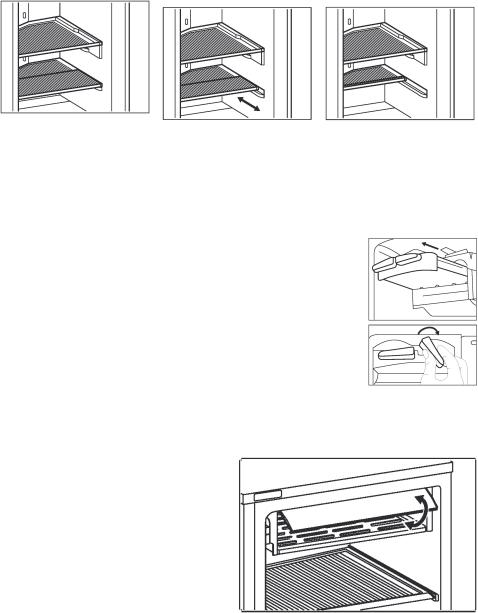
Accessories
Magic Shelf (In some models)
Magic shelf, which is on the crisper cover, was designed to give you more place and comfort placing the things in the appliance. This shelf is mobile so you can arrange long or big containers on the crisper cover.
Making Ice Cubes (In some models)
•Take out the ice making tray
•Fill the water in level of line.
•Place the ice making tray in its original position
•When ice cubes are formed, twist the lever to drop off ice cubes into the icebox.
Do not fill the icebox with water in order to make ice. It can be broken.
Fast Freezing Shelf
•Use the fast freezing shelf to freeze home cooking (and fresh foods which is wanted to freeze) more quickly because of the freezing room’s greater freezing power.
•For opening the shelf pull the cover up, and slide it in to the shelf. You can close it in the same way
Note that; be sure that the cover of fast freezing shelf is closed before closing the compartment door. If not, it can not show its fast freezing power.
UK - 6 -
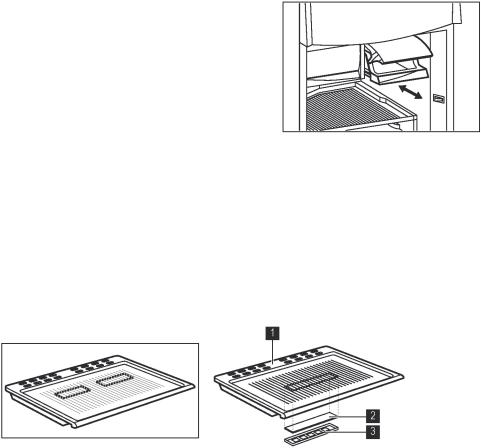
Chiller Shelves
Keeping food in the Chiller compartment instead of the freezer or refrigerator compartment allows food retain freshness and flavour longer, while preserving its fresh appearance. When chiller tray becomes dirty, remove it and wash it with water.
(Water freezes at 0°C, but foods containing salt or sugar freeze at temperature lower than that)
Normally people use the chiller compartment for raw fish, lightly pickled, rice, etc...
Do not put foods you want to freeze or ice trays in order to make ice.
Crisper and Crisper Shelf (In some models)
The crisper compartment absorbs and decomposes ethylene gas (*) emitted from fruits and vegetables with a “FILTER” in the crisper shelf, keeping fruits and vegetables fresh. The filter also eliminates unpleasant odours from inside the crisper, and control the excess water released by the vegetables, maintaining a high humidity environment inside the crisper. When the crisper shelf become dirty, remove the filter by taking out the filter cover and wash the crisper cover with water.
Crisper Cover
Filter
Filter cover
! Do not wash the “Humidity-Control Filter” with water.
(*)NOTE; Ethylene gas is a gas, produced from fruits and vegetables, which accelerates the ageing of fruits and vegetables. For example, spinach and broccoli turn to yellow colour easily in places where ethylene gas is abundant.
UK - 7 -
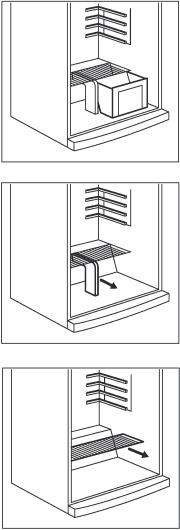
REMOVING THE CRISPER COVER (In some models)
First Step : Removing the crispers
•It is easy to pull out the crisper because of the crisper has rollers.
•Pull the crisper out as far as possible and pull the front part up and out
Second Step: Taking out the partition crisper center between the crispers.
•Bend the Partition toward left from the bottom of the part
•Take out the Partition crisper
Third Step: Taking out the crisper cover
•Pull out the crisper cover until the nails of the cover come on the cavities (right and left side) of the cabinet.
•When the nails comes into the cavities pull up and take out the crisper cover
NOTE: Make the inverse of the same operation for the resetting the crisper cover.
All written and visual descriptions in the accessories may vary according to the appliance model.
UK - 8 -

PART- 3. ARRANGING FOOD IN THE APPLIANCE
Refrigerator Compartment
•To set the refrigerator compartment to 2-3 graphic bar will be enough for normal conditions.
•To reduce humidity and consequent increase of frost never place liquids in unsealed containers in the refrigerator.
•Never place warm food in the refrigerator. Warm food should be allowed to cool at room temperature and should be arranged to ensure adequate air circulation in the refrigerator compartment.
•Arrange the meat and cleaned fish (wrapped in packages or sheets of plastic) which you will use in 1-2 days.
•You can put the fruits and vegetables into crisper without packing.
NOTE: Potatoes, onions and garlic should not be stored in the refrigerator.
Food |
Storing time |
Where to place in the fridge |
|
department |
|||
|
|
||
Vegetables and fruits |
1 week |
In the Crisper (without being |
|
wrapped) |
|||
|
|
||
|
|
Covered with plastic folio and bags |
|
Meat and fish |
2 to 3 days |
Or in a meat box |
|
|
|
(on the glass shelf) |
|
Fresh cheese |
3 to 4 days |
In the special door shelf |
|
Butter and Margarine |
1 week |
In the special door shelf |
|
|
|
|
|
Bottled product, Milk and |
Until the expiry date |
In the special door shelf |
|
Yoghurt |
recommended by the producer |
||
|
|||
Eggs |
1 month |
In the egg shelf |
|
Cooked food |
|
All shelves |
UK - 9 -
Freezer Compartment
•To set the freezer compartment to 2-3 graphic bar will be enough for normal conditions.
•The use of freezer is, storing of deep-frozen or frozen foods for long periods of time and making ice cubes.
•Do not put fresh and warm foods to the freezer door shelves to be frozen. Only use for storage of frozen foods.
•Do not put fresh and warm food with frozen food side by side as it can thaw the frozen food.
•Use the fast freezing shelf to freeze home cooking (and the foods which is wanted to freeze) more quickly because of the freezing room’s greater freezing power.
•While freezing fresh foods (i.e. meat, fish and mincemeat) divide them in parts you will use in one time.
•While freezing fresh foods ; Maximum amount of fresh food (in kg) that can be frozen in 24 hours is indicated on the appliance label.
•For optimum appliance performance to reach maximum freezing capacity, turn the freezer thermostat knob to position max 24 hours before placing fresh food inthe freezer.
•After placing fresh food in the freezer, 24 hours on max position is generally sufficient,After 24 hours, don not need to set the feezer thermostat knob to position max.
•Attention; In order to save energy, When freezing small amounts of food, don not need to set the freezer thermostat knob to position max.
•For storing the frozen foods; the instructions shown on frozen food packages should always be followed carefully and if no information is provided food should not be stored for more than 3 months from the purchased date.
•When buying frozen foods ensure that these have been frozen at suitable temperatures and that the packing is intact.
•Frozen foods should be transported in appopriate containers to maintain the quality of the food and should be returned to the freezing surfaces of the unit in the shortest possible time.
•If a package of frozen food shows the sign of humidity and abnormal swelling it is probable that it has been previously stored at an unsuitable temperature and that the contents have deteriorated.
•The storage life of frozen foods depends on the room temperature, thermostat setting, how often the door is opened, the type of food and the length of time required to transport the product from the shop to your home. Always follow the instructions printed on the package and never exceed the maximum storage life indicated.
Some recommendations have been specified on pages 11, 12 and 13 for the placement and storage of your food in the deep freeze compartment.
UK - 10 -
|
|
Storing time |
In room temperature |
|
Meat and fish |
Preparing |
Defrost time |
||
(months) |
||||
|
|
-hour- |
||
|
|
|
||
Steak |
Wrapping in a foil |
6-10 |
1-2 |
|
Lamb meat |
Wrapping in a foil |
6-8 |
1-2 |
|
Veal roast |
Wrapping in a foil |
6-10 |
1-2 |
|
Veal cubes |
In small pieces |
6-10 |
1-2 |
|
Lamb cubes |
In pieces |
4-8 |
2-3 |
|
Minced meat |
In packages without using spices |
1-3 |
2-3 |
|
|
|
|
|
|
Giblets (pieces) |
In pieces |
1-3 |
1-2 |
|
Bologna |
Should be packaged even if it has |
|
Until it is defrosted |
|
sausage/salami |
membrane |
|
||
|
|
|||
Chicken and turkey |
Wrapping in a foil |
7-8 |
10-12 |
|
|
|
|
|
|
Goose and Duck |
Wrapping in a foil |
4-8 |
10 |
|
|
|
|
|
|
Deer, Rabbit, Wild |
In 2.5 kg portions and as fillets |
9-12 |
10-12 |
|
Boar |
||||
|
|
|
||
Freshwater fishes |
|
|
Until it is thawed |
|
(Salmon, Carp, |
|
2 |
||
|
completely |
|||
Crane, Siluroidea) |
After cleaning the bowels and |
|
||
|
|
|||
Lean fish; bass, |
scales of the fish, wash and dry it; |
4-8 |
Until it is thawed |
|
turbot, flounder |
and if necessary, cut the tail and |
completely |
||
|
||||
Fatty fishes (Tunny, |
head. |
|
Until it is thawed |
|
Mackarel, bluefish, |
|
2-4 |
||
|
completely |
|||
anchovy) |
|
|
||
|
|
|
||
Shellfish |
Cleaned and in bags |
4-6 |
Until it is thawed |
|
completely |
||||
|
|
|
||
Caviar |
In its package, aluminum or |
2-3 |
Until it is thawed |
|
plastic container |
completely |
|||
|
|
|||
Snail |
In salty water, aluminum or plastic |
3 |
Until it is thawed |
|
container |
completely |
|||
|
|
Note: Frozen foods, when thawed, should be cooked just like fresh foods. If they are not cooked after being thawed they must NEVER be re-frozen.
UK - 11 -

Vegetables and |
|
Storing time |
In room temperature |
|
Preparing |
Defrost time |
|||
Fruits |
(months) |
|||
|
-hour- |
|||
|
|
|
||
|
Take the leaves apart, cut |
|
|
|
Cauliflower |
the heart into pieces, and |
10 - 12 |
It can be used as frozen |
|
leave it in water with a little |
||||
|
|
|
||
|
lemon juice for a while |
|
|
|
|
|
|
|
|
String beans and |
Wash and cut to small |
10 - 13 |
It can be used as frozen |
|
beans |
pieces |
|||
|
|
|||
Beans |
Hull and wash |
12 |
It can be used as frozen |
|
Mushroom and |
Wash and cut to small |
6 - 9 |
It can be used as frozen |
|
asparagus |
pieces |
|||
|
|
|||
Cabbage |
Cleaned |
6 - 8 |
2 |
|
Eggplant |
Cut to pieces of 2cm after |
10 - 12 |
Separate them from one another |
|
washing |
||||
|
|
|
||
Corn |
Clean and pack with its |
12 |
It can be used as frozen |
|
stem or as sweetcorn |
||||
|
|
|
||
Carrot |
Clean and cut to slices |
12 |
It can be used as frozen |
|
Pepper |
Cut the stem, cut into two |
8 - 10 |
It can be used as frozen |
|
pieces and remove the core |
||||
|
|
|
||
|
|
|
|
|
Spinach |
Washed |
6 - 9 |
2 |
|
Apple and pear |
Peel and slice |
8 - 10 |
(In Fridge) 5 |
|
Apricot and Peach |
Cut into two pieces and |
4 - 6 |
(In Fridge) 4 |
|
remove the stone |
||||
|
|
|
||
Strawberry and |
Wash and hull |
8 - 12 |
2 |
|
Blackberry |
||||
|
|
|
||
Cooked fruits |
Adding 10 % of sugar in the |
12 |
4 |
|
container |
||||
|
|
|
||
Plum, cherry, |
Wash and hull the stems |
8 - 12 |
5 - 7 |
|
sourberry |
||||
|
|
|
UK - 12 -
|
Dairy Products |
Preparing |
Storing time |
Storing Conditions |
|
|
|
Pastry |
(months) |
|
|||
|
|
|
|
|||
Packet (Homogenize) |
In its own packet |
2 - 3 |
Pure Milk – In its own packet |
|||
Milk |
|
|
|
|
||
|
|
|
|
It can be left in its original |
|
|
Cheese-excluding |
In slices |
6 - 8 |
package for storing for a short |
|||
white cheese |
time. For long term storage It |
|||||
|
|
|||||
|
|
|
|
should be stored in a plastic |
||
|
|
|
|
|
|
|
Butter, margarine |
In its package |
6 |
|
|
||
|
Albumen |
|
10 - 12 |
30 gr of it is equal to a yolk. |
closed container |
|
|
Egg mixture |
Some salt or sugar is |
|
|
||
* Eggs |
added for preventing it |
10 |
50 gr of it is equal to a yolk. |
|||
(Albumen – yolk) |
||||||
from becoming dense. |
|
|
||||
|
|
|
||||
|
Some salt or sugar is |
|
|
|||
Yolk |
added for preventing it |
8 - 10 |
20 gr of it is equal to a yolk. |
|||
|
In |
|||||
|
|
from becoming dense. |
|
|
||
|
|
|
|
|
||
* It should not be frozen with its shells. The white and yolk of the egg should be frozen separately or as having been well mixed.
|
Storing time |
Thawing time in room |
Thawing time in owen (min.) |
|
(months) |
temperature (hours) |
|
|
|
||
Bread |
4 - 6 |
2 - 3 |
4-5 (220-225 °C) |
Biscuits |
3 - 6 |
1 - 1,5 |
5-8 (190-200 °C) |
Pastry |
1 - 3 |
2 - 3 |
5-10 (200-225 °C) |
Pie |
1 - 1,5 |
3 - 4 |
5-8 (190-200 °C) |
Phyllo dough |
2 - 3 |
1 - 1,5 |
5-8 (190-200 °C) |
Pizza |
2 - 3 |
2 - 4 |
15-20 (200 °C) |
|
|
|
|
The taste of some spices found in cooked dishes (anise, basilica, watercress, vinegar, assorted spices, ginger, garlic, onion, mustard, thyme, marjoram, black pepper, etc.) changes and they assume a strong taste when they are stored for a long period. Therefore, the frozen food should be added little amount of spices or the desired spice should be added after the food has been thawed.
The storage period of food is dependent on the oil used. The suitable oils are margarine, calf fat, olive oil and butter and the unsuitable oils are peanut oil and pig fat.
The food in liquid form should be frozen in plastic cups and the other food should be frozen in plastic folios or bags.
UK - 13 -
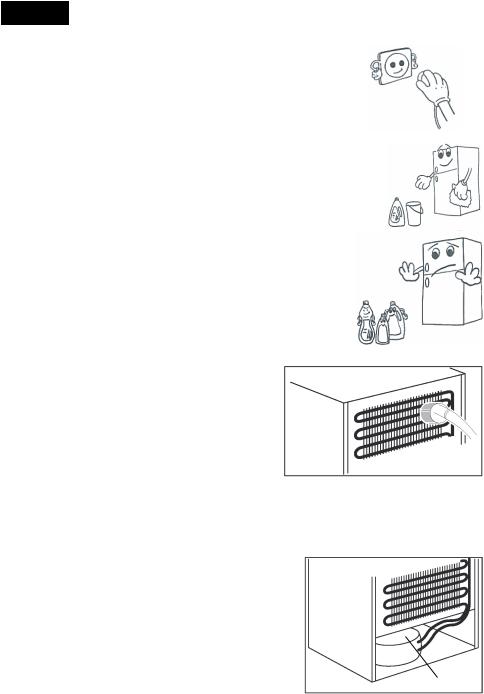
PART- 4. CLEANING AND MAINTENANCE
•Disconnect unit from the power supply before cleaning.
•Do not clean the appliance by pouring water.
•The refrigerator and freezer compartment should be cleaned periodically using a solution of bicarbonate of soda and lukewarm water
•Clean the accessories separately with soap and water. Do not clean them in the washing machine.
•Do not use abrasive products, detergents or soaps. After washing, rinse with clean water and dry carefully. When the cleaning operations have been completed reconnect the plug of the unit with dry hands.
•You should clean the condenser with broom at least once a year in order to provide energy saving and increase the productivity.
THE POWER SUPPLY MUST BE DISCONNECTED.
Defrosting
•Defrosting occurs fully automatically during operation; the defrost water is collected by the evaporating tray and evaporates automatically.
evaporating tray
UK - 14 -

Replacing The Refrigerator and Freezer Light Bulb
1.Unplug the unit from the power supply,
2.Remove the refrigerator light cover with a minus screw driver, and take out the cover.
3.Change the present light bulb with a new one of not more than 15 W.
4.Replace the light cover and after waiting 5 minutes plug the unit.
Freezer compartment |
Cooler compartment |
PART- 5. TRANSPORTATION AND CHANGING OF INSTALLATION POSITION
Transportation and Changing of Installation Position
•The original packages and foamed polystyrene (PS) can be concealed if required.
•In transportation the appliance should be tied with a wide stripe or a strong rope. The rules written on the corrugated box must be applied while transporting.
•Before transporting or changing old installation position, all the moving objects (i.e., shelves, crisper…) should be taken out or fixed with bands in order to prevent the shake.
Changing of Door Opening Direction (For some models)
In case you need to change door-opening direction, please consult the domestic after sales service.
UK - 15 -

PART- 6. BEFORE CALLING YOUR AFTER SALES SERVICE
What to do if your refrigerator does not operate;
Check that;
•There is no power ,
•The general switch in your home is disconnected ,
•The thermostat setting is on «0» position ,
•The socket is not sufficient. To check this, plug in another appliance that you know which is working into the same socket.
What to do if your refrigerator performs poorly;
Check that;
•You have not overloaded the appliance ,
•The doors are closed perfectly ,
• There is no dust on the condenser ,
• There is enough place at the rear and side walls.
IIf your fridge is operating too loudly;
Normal Noises
Cracking (Ice cracking) Noise:
•During automatic defrosting.
•When the appliance is cooled or warmed (due to expansion of appliance material).
•Heard when the thermostat switches the compressor on/off.
Compressor noise
•Normal motor noise. This noise means that the compressor operates normally
•Compressor may cause more noise for a short time when it is activated.
Bubbling noise and splash:
•This noise is caused by the flow of the refrigerant in the tubes of the system.
Water flow noise:
•Normal flow noise of water flowing to the evaporation container during defrosting. This noise can be heard during defrosting.
Air Blow Noise:
•Normal fan noise. This noise can be heard in No-Frost fridge during normal operation of the system due to the circulation of air.
If your fridge is not cooling enough;
Your fridge is designed to operate in the ambient temperature intervals stated in the standards, according to the climate class stated in the information label. We do not recommend operating your fridge out of stated temperatures value limits in terms of cooling effectiveness.
UK - 16 -
Climate Class |
Ambient Temperature (°C) |
|
T |
Between 16 and 43 |
(°C) |
ST |
Between 16 and 38 |
(°C) |
N |
Between 16 and 32 |
(°C) |
SN |
Between 10 and 32 |
(°C) |
•Tropical Climate Class is described as between 16°C and 43°C of ambient temperatures according to EN ISO15502 standards.
•Appliance complies with EN15502, IEC60335-1 / IEC60335-2-24, 2004/108/EC standards.
IMPORTANT NOTES:
•Compressor protection function will be activated after sudden power breakdowns or after unplugging the appliance, because the gas in the cooling system is not stabilized yet. Your fridge will start after 5 minutes, there is nothing to worry about.
•If you will not use your fridge for a long time (e.g. in summer holidays) unplug it. Clean your fridge according to Part 4 and leave the door open to prevent humidity and smell
•If the problem persists after you have followed all the instructions above, please consult to the nearest service.
•The appliance you bought is designed for home type use and can be used only at home and for the stated purposes. It is not suitable for commercial or common use. If the consumer use the appliance in a way that does not comply with these features, we emphasize that the producer and the dealer shall not be responsible for any repair and failure within the guarantee period.
•The lifetime of your appliance stated and declared by the Department of the Industry is 10 years (the period for retaining parts required for the proper functioning of the appliance).
UK - 17 -
